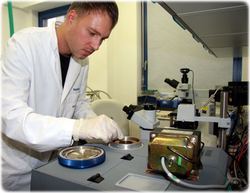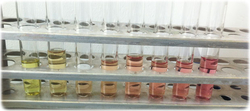You are here: Home / Cryo Competence Center Life Science / Laboratory Analytics
Testing and analysis: flexible and according to customer request
Research and development in the field of pharmacy, biology, cell biology and regenerative medicine have high analytical requirements. Our labs have a complete set of equipment for quantitative material analysis as well as physical, chemical, biological and medical tests. As an example of our analytical spectrum of methods, we demonstrate the development of a regenerative medicine product for wound closure based on collagen (implantable collagen sponge):
Assurance of raw material quality of complex biopolymers
A strict monitoring of the raw material quality in all process steps is of special importance during the manufacturing of medical products based on collagen. We check the raw material (split hide and tendons) for foreign proteins, receipt of the native protein structure, fat residues and salts, preservatives and many more at receiving and during the processing to solution or fiber suspension.
Establishment and monitoring of quality criteria for the manufacturing process
We identify the tendency to aggregation in fiber suspensions through determination of size and shape distribution of the fibers. We determine the eligibility- and processability of acidic collagen suspension for implantable collagen sponges by rheometrical measurements.
Testing of performance and application safety of medical products
We prepare meaningful histological specimens for microscopic analysis of material structure, macro- and micro-porosity and pore size distribution from the produced collagen sponge. If the transplant is stabilized against hydrolytic or cell mediated degradation in biological milieu, the success of crosslinking could be quantified thermoanalitically. By in-vitro tests in an aqueous environment with enzymes or human cells, it is possible to determine degradation kinetics in the defect to optimize the biomaterial for its designed purpose. By contact of the material or extracted components with serum and human primary cells it is possible to verify a pyrogenic effect. Hereafter chromatographic methods provide a specific search for contaminations and toxic degradation products. Mechanical load and restoring behavior can be determined by sequential tensile and compression testing.






